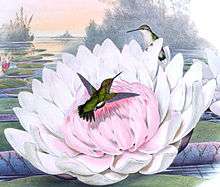Short-tailed emerald
| Short-tailed emerald | |
|---|---|
 | |
| Poortman's emerald hummingbird male center, female above right John Gould, 1860 | |
| Scientific classification | |
| Kingdom: | Animalia |
| Phylum: | Chordata |
| Class: | Aves |
| Order: | Apodiformes |
| Family: | Trochilidae |
| Genus: | Chlorostilbon |
| Species: | C. poortmani |
| Binomial name | |
| Chlorostilbon poortmani Bourcier, 1843 | |
The short-tailed emerald (Chlorostilbon poortmani) is a species of hummingbird found in the Andes of Colombia and Venezuela. It has also been called Poortman's emerald hummingbird.[2]
The binomial name was given by Jules Bourcier (1797–1873), a French naturalist and expert on hummingbirds.
Range, habitat and population
The short-tailed emerald is found in clearings and at borders of forest, woodland, open areas with scattered trees, and in coffee plantations at altitudes of up to 2,400 metres (7,900 ft) in the Andes of central Colombia to far western Venezuela. The bird has a wide range, estimated at 64,000 square kilometres.[1]
The global population and population trends have not been quantified. Although the species is described as 'uncommon' in parts of its range, it is not believed to be near the threshold for inclusion in the IUCN Red List (viz., the population is not thought to be fewer than ten thousand mature individuals, with numbers declining).[1]
Description
The bird has an overall length of approximately 9 centimetres (3.5 in). The bill is straight, about 18 millimetres (0.71 in) long and black.[3]
The short-tailed emerald closely resembles several other members of the genus Chlorostilbon. While its tail is relatively short, a few other species from the genus have equally short tails (e.g. the green-tailed emerald). The male's bird's whole crown and belly are a solid glittering emerald green, with iridescence, the back a shining green, while the feathers of his short tail are a darker olive green. The female bird also has a shining green back, but her crown is nearer to brown in colour, while her underparts are grey, and she has a short white streak behind her eye. Her tail is pale green, with two central feathers of shining green and with an off-white tip and a blue-black subterminal band.[3]
Subspecies
There are two subspecies, the Santander emerald (Chlorostilbon poortmani euchloris) and the short-tailed emerald (Chlorostilbon poortmani poortmani).[4][5]
In art
The English ornithologist John Gould depicts Poortman's emerald hummingbird in a lithograph dated 1860, from the neighborhood of Bogotá, Colombia, with a Victoria water lily against the background of a lake,[2] a juxtaposition which has been called "one of the most striking examples of a plant chosen for its fame and beauty rather than its appropriateness".[6]
Bibliography
- Gould, John, A Monograph of the Trochilidae or Humming Birds with 360 plates (volume 5, 1861)
- BirdLife International, Threatened Birds of the World (Lynx Edicions and BirdLife International, Barcelona, Spain and Cambridge, UK, 2000)
- BirdLife International, Threatened Birds of the World 2004 (CD-ROM, BirdLife International, Cambridge, UK, 2004)
References
- 1 2 3 BirdLife International (2012). "Chlorostilbon poortmani". IUCN Red List of Threatened Species. Version 2013.2. International Union for Conservation of Nature. Retrieved 26 November 2013.
- 1 2 Gould, John, A Monograph of the Trochilidae or Humming Birds with 360 plates (5 volumes, 1849–1861); 'Poortman's Emerald Hummingbird' is Plate 358 in volume 5 (1861) but the lithograph was published in 1860
- 1 2 Hilty, Steven L., & Brown, Bill, A guide to the birds of Colombia (Princeton University Press, 1986, ISBN 978-0-691-08372-8) page 266 online at books.google.co.uk, accessed 8 August 2008
- ↑ Chlorostilbon poortmani at discoverlife.org, accessed 8 August 2008
- ↑ ornitaxa.com, accessed 8 August 2008
- ↑ Lambourne, Maureen, 'John Gould, Curtis's Botanical Magazine and William Jameson' in Curtis's Botanical Magazine, Volume 16, Issue 1 (February 1999), p. 33 online at ingentaconnect.com (subscription required), accessed 8 August 2008
